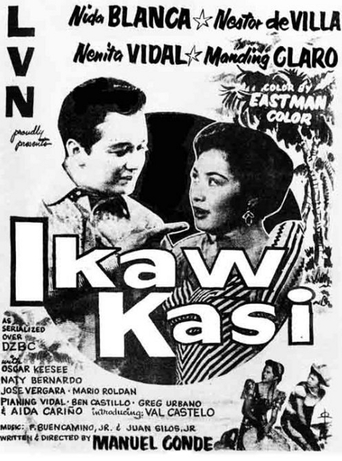

Made during what many consider to be the Golden Age of Philippine movies (after the Pacific War to the early '60s), this is just one of many musical-comedy-romance movies of the era. Nida Blanca and Nestor de Villa though never lovers in real life were the quintessential "love team" of the era with many movies to their credit. With the advent of the television age, they essayed this comedy-romance formula into a variety show naturally dubbed The Nida-Nestor Show." But inarguably, this was their best picture in terms of production value and directorial as well as editing competence. Strange that I recall this movie in color but it is labeled here as black and white.Films of this genre made much use of the Filipino musical tradition of the "Kundiman," a sweetly sentimental (some say too sweet) class of love songs with a touch of pathos. The word comes from the Tagalog phrase : "Kung Hindi" man (meaning "even if I am not"). So typically the lyrics would have the man saying that even if he is not worthy because he is poor, lowly born or not handsome, may the lady he is wooing deign to listen to his expressions of love or accept his proposal. In many ways, the tradition echoes the ethos of the European troubadours except that in the Philippine case, the purveyors were not the high born knights and scholars but the lowly tenant farmers - truly the oppressed of the earth. But of course, there were also some comic love songs which were the forte of Nida and Nestor. They could dance too and Nida Blanca was really a gifted comedienne with knockout beauty to match.Ironically, this was released during the height of the communist-inspired "Huk" rebellion with armed partisans practically knocking at the doors of Manila with a pincer movement from the North in Central Luzon where agrarian unrest was rife in the provinces of Bulacan, Tarlac, Pangasinan and Nueva Ecija and from the South in the Tagalog provinces of Batangas, Laguna and Cavite. The word Huk comes from Hukbong Mapagpalaya ng Bayan (Army for the Liberation of the People), a direct descendant of the communist partisan guerrilla resistance against the Japanese during the Pacific War. The original name was Hukbo ng Bayan Laban sa mga Hapon (People's Army to Fight the Japanese) or the famous HukBaLaHap.Left leaning intellectuals and activists of the '60s and the '70s disdained and denounced art works (including movies) depicting rural life as a kind of perpetual happy fiesta. Falling under their denunciations were paintings by acclaimed national artist Fernando Amorsolo the more famous of whose works showed comely maidens dancing the "tinikling" (an intricate folk dance where the dancers' feet evade clapping bamboo poles) while the men play guitars and prepare roasted pig called "lechon." Some of these activists and their sympathizers eventually became movie makers themselves and under the principles of cinema verite made films depicting the true condition of the farmers and poor people during the '70s and '80s. They eventually came to the attention of the Dictator Marcos who tried to ban their works as he considered them an indictment and a threat to his rule. But those films won acclaim in international venues that it became good PR for the dictatorship to allow their local release and even claim credit for their success. I wish my fellow Filipinos would help me review these films. I can't do it alone! I didn't see all of them.A sad footnote to the lead star of Ikaw Kasi is this: Nida Blanca was brutally murdered and the chief suspect her dependent American husband named Strunk, a former bit movie player and one record wonder singer, escaped to the United States.
... View More